School playgrounds are vibrant spaces filled with a variety of equipment designed to encourage physical activity, social interaction, and imaginative play among students. These pieces of playground equipment come in many shapes, sizes, and functionalities, each contributing uniquely to the developmental and recreational needs of children. Below is an overview of some common playground equipment names, along with brief descriptions to help you identify them more easily.
1. Slides
One of the most iconic pieces of playground equipment, slides allow children to experience the thrill of speed and gravity as they move from a higher platform to the ground. Slides come in various designs including straight, wavy, spiral, and tunnel slides.
2. Swing Sets
Swing sets are quintessential playground fixtures that promote balance and coordination. They can include individual swings, baby swings, tire swings, and adaptive swings for children with special needs. Swing sets often feature bars for hanging or sitting.
3. Monkey Bars
Also known as horizontal ladders or jungle gyms, monkey bars challenge children’s upper body strength and coordination. Kids can hang, swing, and move from one bar to another, developing their motor skills and confidence.

4. Seesaws
Seesaws, or teeter-totters, provide a fun way for children to engage in cooperative play. Two or more kids can sit on opposite ends and use their weight to lift and lower each other, promoting teamwork and balance.
5. Climbing Structures
Climbing structures such as climbing domes, cargo nets, and rock walls offer various levels of complexity and challenge. These structures help improve children’s gross motor skills, problem-solving abilities, and self-confidence.
6. Merry-Go-Rounds
Merry-go-rounds are circular platforms powered by pushing or turning mechanisms. Children can spin around either sitting or standing, enjoying the dizzying sensation while practicing their motor skills.
7. Sandbox
A sandbox is a shallow box filled with sand where children can dig, build sandcastles, and engage in imaginative play. Sandboxes encourage creativity and fine motor skills development through activities like digging and sculpting.
8. Bouncers/Spring Riders
Bouncers and spring riders provide a bouncy surface that children can hop on or ride. These pieces of equipment are excellent for developing balance and coordination while offering sensory stimulation through the bouncing motion.
9. Playground Bridges
Playground bridges, whether suspended rope bridges or sturdy wooden ones, add an element of adventure to the playground. They help develop balance and spatial awareness as children walk across them.
10. Musical Instruments
Many modern playgrounds incorporate musical instruments like drums, xylophones, and bells into their design. These elements introduce children to sound exploration and rhythm, fostering a love for music and creative expression.
Conclusion
The diverse array of playground equipment available at schools plays a crucial role in the physical, social, and cognitive development of children. From traditional slides and swing sets to innovative climbing structures and musical instruments, each piece offers unique benefits that contribute to a well-rounded and engaging play environment. Knowing the names and functions of these playground items can enhance both the educational experience and the enjoyment of students during recess and physical education classes.




